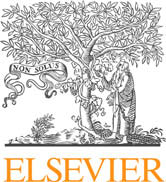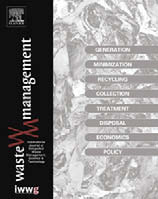3. Results and discussion
3.1. TS/VS degradation
Six feedstocks were subjected to decomposition under conditions
found in the inlet zone of the PFBR. The PFBRs are designed
to trap freshly fed biomass feedstocks under previously fed biomass
at the inlet zone. This forced submergence initiates rapid
decomposition (mostly acidogenesis) among biomass feedstocks,
and VFAs produced here are expected to be diffused into the digester
liquid and subsequently decomposed to biogas in the liquid
zone itself (Chanakya and Moletta, 2005). As rates of acidogenesis
slow, methanogens colonize this biomass and some biomass begins
to float above the digester liquid, while biomethanation continues
due to a balanced rate of VFA production and utilization
in such a biomass. Such a model of functioning is only partly explained
experimentally (Jagadish et al., 1998; Chynoweth et al.,
1992). Among the six feedstocks, banana peel, cabbage waste,
and orange peel had similar kinds of decomposition patterns,
involving a very rapid initial decay where between 75% and 95%
of initial TS fed decomposed within 4 d of residence time (Figs. 1
and 2). TS and VS loss have very similar patterns among these three feedstocks. The decomposition is not adequately explained by an
exponential decay pattern (Figs. 1 and 2). The main source of variation
arises because of the very rapid initial decomposition. More
sampling points are required to understand and model this initial
phase for these kinds of feedstocks. These rates are far higher than
reported earlier, and are desirable for rapid conversion to biogas
(Kalia et al., 2000; Dahiya and Vasudevan, 1987; Kalia and Joshi,
1995; Sharma et al., 1988)
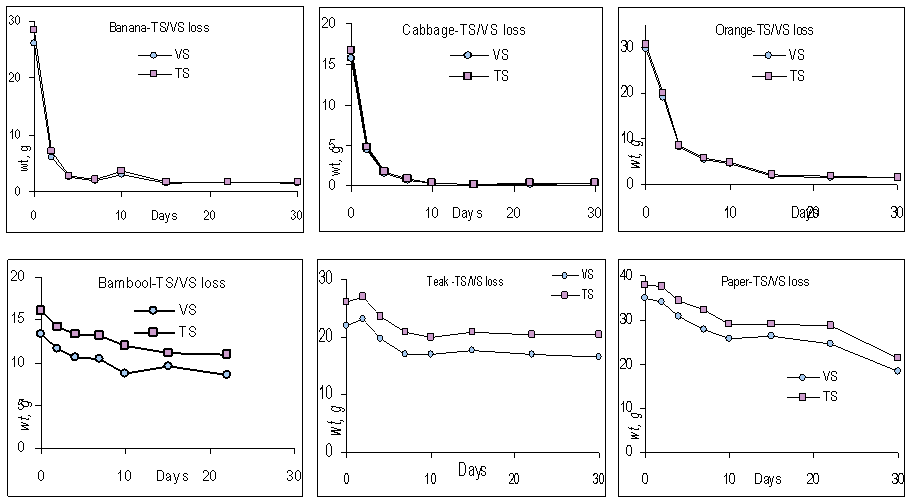
Figure 1: TS and VS lost among various feedstocks fermented in a typical plug flow biogas reactor under conditions of complete submergence.
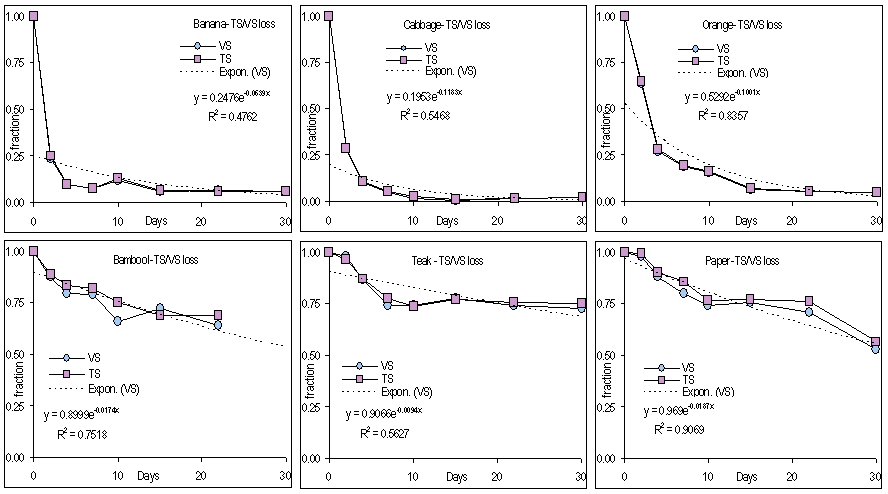
Figure 2 : Fraction of TS and VS lost among various feedstocks fermented at the inlet of a typical plug flow biogas reactor under conditions of complete submergence.
On the other hand, leaf biomass (paper mulberry), mixed fruit wastes, and sugarcane bagasse used as feedstocks in a solid state fermentor have been reported to decompose with an ideal exponential decay pattern (Chanakya et al., 2007a). In comparison, it is clear that total submergence, as in a PFBR, tends to achieve a rapid or even a higher degree of acidogenic decomposition as compared to solid state fermentation (Chanakya et al., 1999). The decomposition pattern has been studied here, and these rates and patterns are compared to similar studies (Chanakya et al., 2007a). However, when each step of MSW digestion has been quantified, it is possible to use Monod kinetics (Nopharatana et al., 2007). The above discussion and Figs. 1 and 2 show that these three feedstocks will decompose rapidly in the initial stages, and thus have the potential to accumulate a large amount of VFA in the inlet zone. To avoid disrupted biogas production, there is a need to convert or disperse these potentially high concentrations of VFA, in order to sustain good biogas production when PFBRs are fed predominantly with these feedstocks.
Bamboo leaves, teak leaves, and newsprint paper feedstocks showed slower decomposition rates, reaching between 25% and 45% TS/VS loss over a 30-d fermentation period (Figs. 1 and 2). Unlike the earlier three feedstocks, there were significant differences between the TS and VS contents of these feedstocks (Fig. 1), indicating the presence of a significant fraction of minerals (ash) in the feedstocks. There were marginal differences between the degradation of TS and VS among these feedstocks (Fig. 2). These three feedstocks decomposed in a pattern resembling exponential decay, with values of paper (r = 0.948) and bamboo and teak leaves (r = 0.866). Earlier studies indicate similar decomposition rates for leaf biomass with an exponential decay pattern (Chanakya et al., 2007a). Decomposition levels achieved are adequate for use in biogas plants, and potential ways to improve the extent of decomposition need to be examined.
3.2. Breakdown of constituents among feedstocks
Banana peels are largely composed of hot water soluble pectin, cellulose, and hemicelluloses, which together constitute nearly 80% of the mass. Their degradation is very rapid (Fig. 3), and a majority of the mass of banana peels is lost in a residence time of 2 d. There was very little residue left after a 4 d SRT. This rate is much faster than some of the earlier reports where rapid conversion to gas lasts up to 2 weeks (Sharma et al., 1988). The degradation is accompanied by loss of lignin fraction as well. This pattern of degradation suggested that much of this waste will disintegrate within the inlet/ pre-treatment chamber of the PFBR with a potential to generate a large flux of VFA. The cellulose content in this study is small compared to that reported earlier (Sharma et al., 1988). PFBRs using this as the predominant feed (fruit juice vendors, fruit processing industries) need to account for the potential for a large VFA flux in the design of the inlet.
Cabbage waste followed a trend similar to banana peels. It contains cellulose, hot water soluble pectin, hemicellulose, and oxalate pectin as the dominant constituents (in that order of abundance). More than 80% of the loss in mass in the nylon mesh bags occurred within a 2 d SRT, and very little residue remained after a 4 d SRT. There was very little lignin content in the feedstock. Also, very little residue remained after 10 d for sampling and determination of the composition. From this data we observe that cabbage waste, just as in the case of banana peels, has a high tendency to release a large VFA flux in the vicinity of the inlet of a PFBR. With cabbage or similar leaves as predominant ingredients in MSW, it is important to disperse VFA pockets near the inlet. Inlet design and digester operation needs to be suitably modified. Furthermore, as a consequence of its greater extent of degradation, very little digested material is expected to emerge from the digester as anaerobic compost. In many parts of India, road-side ‘Chinese’ food outlets generate wastes dominated by cabbage and cauliflower leaves. In areas populated by such outlets, MSW will have these fermentation characteristics.
Orange (and citrus) peels form a large component of wastes generated from fresh fruit juice vending shops on the road side. Orange peels are composed largely of pectin-1 (hot water soluble), cellulose, and pectin-2 (ammonium oxalate soluble). Decomposition of these constituents is rapid (Figs. 1 and 2), and over 90% of the material is lost in a 4 d SRT. During this rapid decomposition period, a significant loss of lignin and hemicellulose was recorded. Considering that lignin is known to be largely recalcitrant under anaerobic conditions, the disappearance of lignin from the nylon mesh bags could largely be brought about by tissue disintegration and its subsequent escape from the nylon mesh bags into the digester liquid. Further experimentation needs to be carried out to confirm this possibility. This phenomenon of over 90% loss of TS/VS and its constituents suggests that recovery of anaerobic compost from this feedstock is likely to be poor after anaerobic digestion. Reports also indicate that there is some form of toxicity during digestion of citrus peels (Mandal and Mandal, 1997) and, therefore, that the inlets and operation of PFBRs need to be altered in the presence of a large fraction of citrus peels.
Bamboo leaves are found in large quantities both as seasonal leaf litter as well as when bamboo is harvested for paper in other areas. This is a potential source of energy at the point of the bamboo plantations. The pattern of decomposition, as well as its suitability for biogas production, was examined. The pectin fractions are much lower, and the leaves are more lignified, as seen in Fig. 3. Cellulose, hemicellulose, and lignin fractions are higher relative to the earlier three feedstocks. The decomposition rates of all fractions (other than lignin) are gradual. About 30% VS decomposition was achieved. The lignin fraction remained undecomposed up to a 30 d SRT. It is not clear whether the presence of lignin had slowed down the decomposition, and methods to raise the rate of decomposition of these fractions need to be developed. Under existing conditions, a significant part of the feed will end up as digested feed or anaerobic compost.
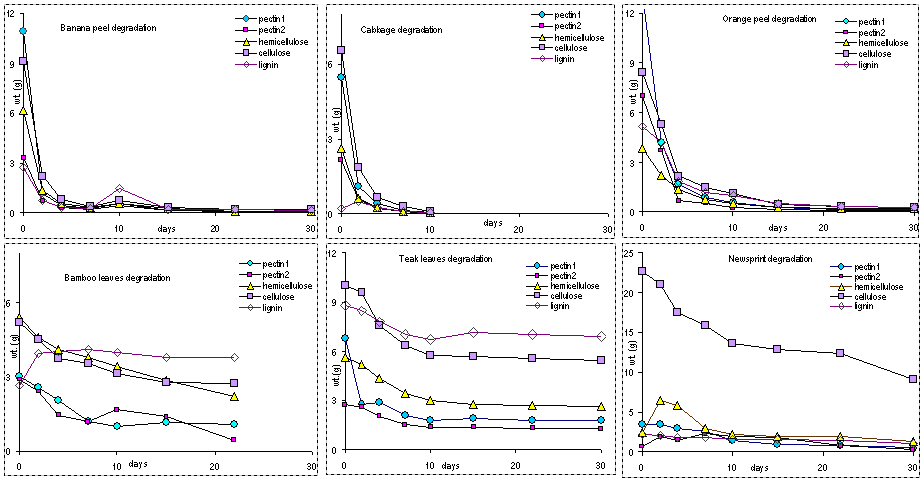
Figure 3: Main fractions of feedstocks lost during different periods of fermentation [legend --o--pectin 1 (water extract), --□—pectin 2 (hot oxalate extract), --▲—hemicellulose (0.5M acid extract), --■— cellulose (72% acid extract), --◊—lignin (72% acid ash-less residue)].
A large quantity of teak leaves is available as leaf litter under teak plantations. They are often removed due to their presence being a fire hazard and thus constitute a potential source of biomethanation feedstock. Teak leaves had the highest contents of cellulose and lignin (predominant fractions) among the six feedstocks studied. The pectin fractions were relatively low. Just as in the case of bamboo, teak leaves decomposed slowly, resulting in a 30% decomposition of the cellulose and hemicellulose fractions and 50% of the pectin-1 fraction. The small change in lignin content suggests that only a small component of the whole leaf is disintegrated and lost from the bags. There were very little TS, VS, or subcomponents lost after 10 d, and this result needs to be investigated further. Unlike the first three samples, a significant fraction of the material remained undigested, and thus it is possible to expect a high level of throughput in the form of compost while using this as the main feedstock.
Soiled newsprint occurs as a large single component of OFMSW because it is used both as a packing material of dry merchandise as well as carry bags for many food items. In Bangalore, it is generated in point and non-point sources. Such moist and soiled newsprint cannot be recycled, and hence biomethanation could be a viable option. As expected, the major constituent of newsprint is cellulose, and the major decomposition occurs in the cellulose constituent of the newsprint. It is seen that in the inlet of the PFBR, newsprint decomposes even when used singly as a feedstock. Obviously, nutrients required by microorganisms for decomposing a material like newsprint are available in the digester liquid in the inlet region. This suggests that in the presence of a significant paper/ newsprint fraction, decomposition is quite effective. However, a significant content of cellulose is still left undecomposed after a 30 d SRT and further investigations are required to make the decomposition more efficient. The presence of a 50% undecomposed fraction indicates the potential to recover a larger fraction of the input as compost when paper becomes the dominant fraction in the feedstock.
3.3. Biological methane production assay
In this study, we have used the BMP assay both as an estimate of the gas production potential, as well as a diagnostic indicator to determine susceptibility to VFA flux or overproduction, and the related process stability when these individual feedstocks are used in large proportions within the OFMSW. The result of BMP assay at a 1% concentration of feedstock is presented in Fig. 4. In the case of banana peels, in spite of a high rate of degradation, the BMP assay showed a high biogas yield of 400 mL/g TS, and the methane content of the gas very quickly reached high levels. All of these results indicate a potential for balanced methanogenesis at moderate feed rates. In spite of the rapid degradation of banana peels (Figs. 2 and 3), the biogas production extends over a 30 d period. The loss of TS, VS and sub-components shows different trends compared to earlier reports (Sharma et al., 1988). This needs further research to identify which stage of anaerobic digestion is retarded (Nopharatana et al., 2007).
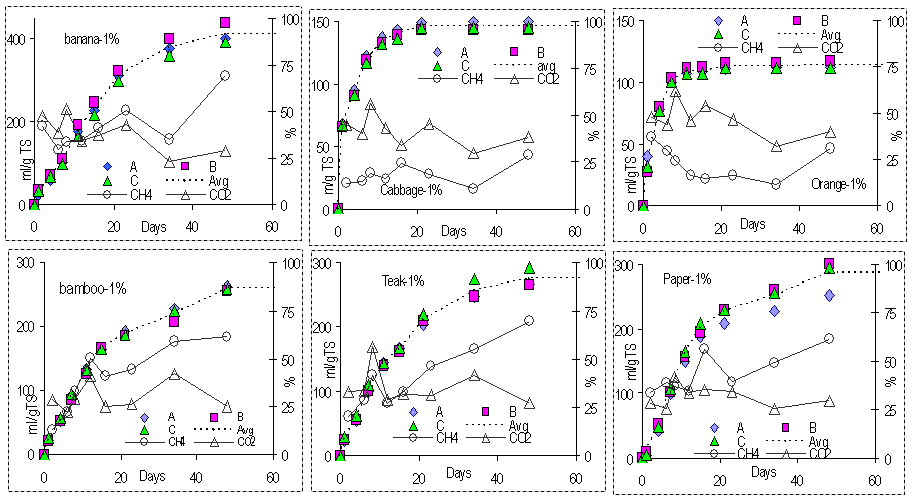
Figure 4: Biological methane potential (BMP) and head space gas composition measured during various stages of BMP assay for the six feedstocks studied.
Unlike typical leaf biomass feedstocks, cabbage waste and orange peels showed poor gas production potential even at a 1% concentration. VS, TS, and sub-component loss (Figs. 2 and 3) show evidence of rapid hydrolysis and disintegration of these feedstocks. In the BMP assay, the CO2 concentration generally exceeded the CH4 concentration, which suggests that the methanogenesis is arrested. This result shows that with cabbage or citrus peels, there is a tendency for rapid VFA buildup and a stalled methanogenesis. This needs to be verified with additional research on the VFA buildup at the initial stages. Use of PFBRs with these feedstocks then requires operating strategies or design modifications such that rapidly generated VFAs are converted to biogas. In this study, the ultimate BMP could not be determined, apparently due to VFA overload. In spite of using methanogen-enriched inoculum, there is evidence of VFA overload, suggesting that VFA buildup occurs to levels above inhibitory thresholds (5 g/L, Chanakya et al., 1993). From the data recorded, it was not clear whether citrus peels produced other forms of toxicity to normal methanogenesis (Mandal and Mandal, 1997). All of these unknowns need to be investigated in the future.
In the case of bamboo and teak leaves (leaf litter), both produced a BMP level in the range of 250–300 mL/g TS, which is generally low for a leaf biomass feedstock. Decomposition of intact bamboo and teak leaves is low under typical digester conditions, and it is higher under the BMP assay conditions. The BMP assay used powdered feedstock, and this suggests that powdering is an effective way to improve gas production for these two feedstocks, a supposition that needs to be investigated. Bamboo and teak plantations show very large levels of leaf litter production, which poses a great fire hazard. Bamboo leaves are also obtained in large quantities during extraction for paper. Conversion to biogas enables recovery of the energy potential of such litter. Considering the high lignin content of both of these feedstocks, it appears that lignin retards and reduces the BMP achievable. Although these two could be used as a potential feedstock, the yields are marginally higher than that of cattle dung and hence could be classified as poor substrates. Similarly, newsprint also decomposed to only a small extent, and the BMP reached 300 mL/g TS. A significant quantity of cellulose was left unused (Fig. 3) even after 15 d. Thus, there appears to be the potential to increase the gas yields even higher when more of the remaining cellulose is made to decompose. Technology alternatives for this option need to be developed.
| E-mail | Sahyadri | ENVIS | Energy | GRASS | CES | IISc | E-mail |


